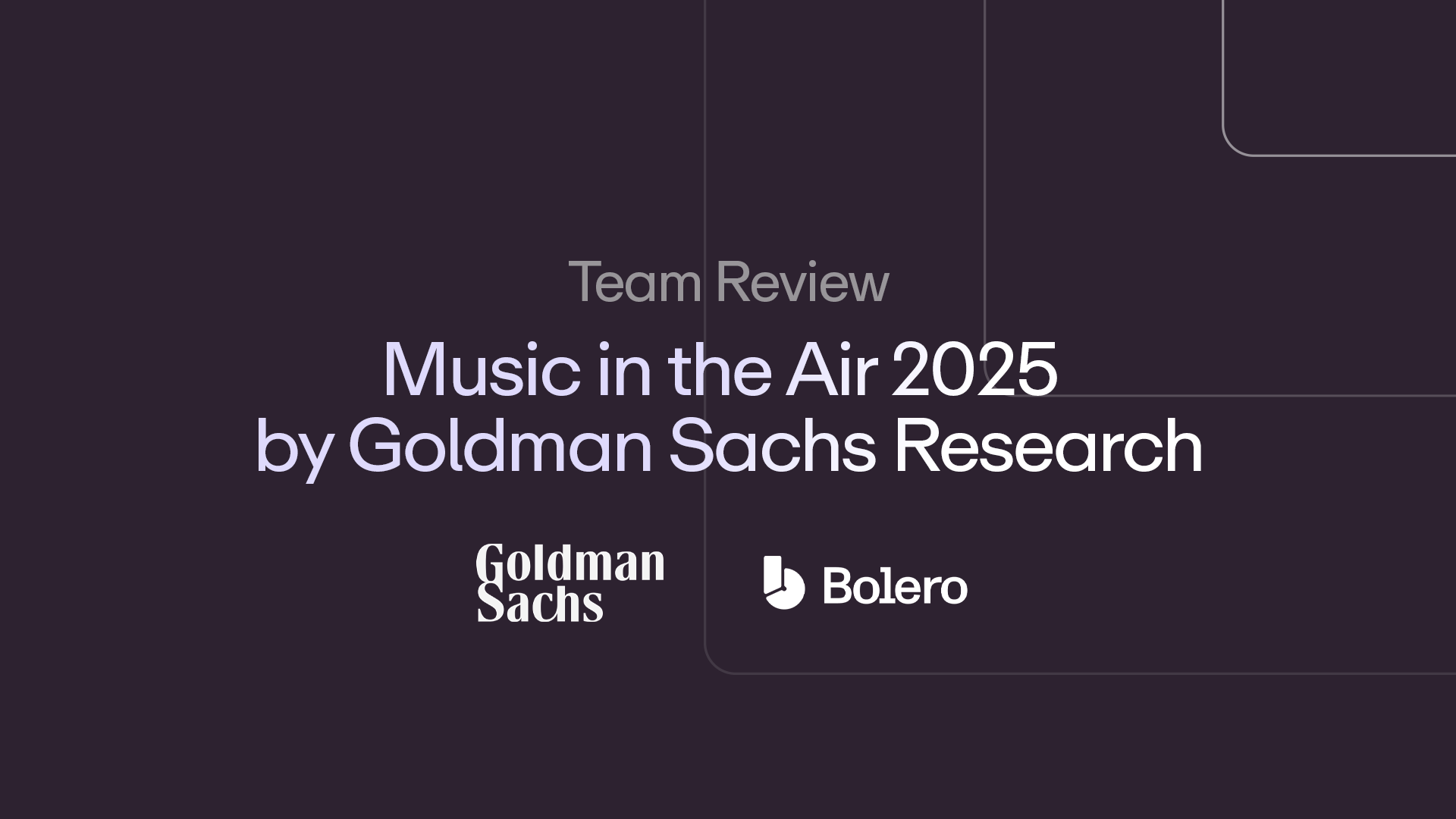Introduction
Goldman Sachs Research’s Music in the Air 2025 offers a clear-eyed, ambitious snapshot of the global music industry. Across nearly 80 pages of sector analysis, financial projections and cyclical indicators, the report has become essential reading for investors, rightsholders, platforms and analysts alike.
After several post-Covid boom years, growth is temporarily slowing, but the long-term picture remains compelling: structural demand, powerful new geographic engines, and a durable shift to a data-driven, subscription-centred model.
Here are the 10 key points we take away, along with our own perspectives, on how to invest in music rights with discernment, build a diversified portfolio and capture culture-anchored, recurring income.
1. Global growth confirmed through 2035
The global music market reached $40.5bn in 2024, up +7.5% year-on-year (vs +14% in 2023). Goldman Sachs trims forecasts slightly, yet still sees a $110.8bn market by 2030, and projects continued growth to 2035, with ARPU rising to $41 in 2035 (from $39.9 in 2024).
Goldman Sachs expects industry revenues to grow +7.7% YoY in 2025, then sustain +5% – 7% thereafter. By segment, the path remains robust:
- Recording: $29.6bn (2024) → $43.4bn (2030)
- Publishing: $9.9bn (2024) → $14.9bn (2030)
- Live: $34.6bn (2024) → $52.6bn (2030)
"Amid uncertainty, music rights display remarkable structural resilience. For investors, this is a low-cyclical asset with recurring cash flows. Short-term slowdowns don’t derail the long-term trajectory." - William Bailey, CEO
2. Paid streaming remains the primary growth engine
Streaming is set to grow from $39.8bn (2024) to $81.1bn (2035)—74% of the total market by then. Expansion is led by paid subscriptions, even as ARPU moderates in mature markets.
Penetration still lags other digital entertainment: in the UK, ~48% pay for music streaming vs 57% for gaming and 85% for SVOD.
Pricing remains fragmented: Spotify Premium is ~€10.99/month in Europe, while local plans in India/Indonesia can range $0.80–$1.50. This temporarily dampens global monetisation, but creates long-term ARPU uplift levers. Major platforms—Spotify, Apple Music, YouTube Music, Amazon Music—will need to balance access and profitability.
On revenue split, Goldman Sachs notes most streaming income is paid to rightsholders via pro-rata or user-centric models. Typically ~70% of net revenue is redistributed across labels (masters), publishers (publishing) and artists, with ~30% retained by the platform—aligning streaming growth and rightsholder income.
"Platforms and DSPs have begun lifting prices. The cumulative effect is meaningful for right-holders, unlocking a better monetisation per user and an increasing ARPU" - William Bailey, CEO
3. Emerging markets are reshaping the growth map
Goldman Sachs devotes an entire section to emerging markets, now the chief engine of subscription growth. Since 2021, they have contributed 50%+ of new subs, nearly 60% in 2024. By 2035, they could account for up to 75% of net adds—driven by China, Brazil and Mexico—even though only ~8% of the internet population currently pays for music.
The upside is substantial, supported by a large freemium base that converts over time as markets mature. Case in point: Tencent Music’s paying ratio climbed from 4% (2018) to 21.5% (2024), and is projected to reach ~24% by 2026. In India, GS estimates ~20m paid subs out of ~200m MAUs in 2023 (~10% conversion).
Across Africa, paid ratios are still very low single digits, yet the arrival and expansion of Spotify, YouTube Premium and Apple Music are steadily lifting monetisation versus low-ARPU local services. As the gap between free and premium experiences widens, conversion should accelerate.
"For music-rights investors, these markets are critical growth vectors—often less synchronised with Western cycles and offering unsaturated, long-duration upside." - William Bailey, CEO
"Emerging markets are not just a geographic relay—they reflect a cultural and economic shift in music consumption. Double-digit growth in regions like WANA is organic rather than manufactured. The challenge is ensuring efficient, transparent rights collection" - Alain Zovighian, Head of Music
4. Publishing rights are outperforming
The report underscores the rise of publishing rights as a stable, diversified and durable value driver. Unlike master income—often concentrated in a few hits or dependent on an artist’s active cycle—publishing tends to be structurally resilient.
Publishing revenues are multi-channel: performance (TV, radio, public performance), mechanicals (physical and interactive streaming), synchronisation (ads, film, gaming, series) and derived uses—covers, interpolations, samples—which can revitalise catalogues, notably in hip-hop, R&B and afrobeats.
Goldman Sachs projects publishing to reach $12.5bn by 2030 (from $8.3bn in 2023; CAGR ~6.1%). Sync in particular should rise from $1.6bn (2023) to $3.4bn (2040), powered by content platforms (Netflix, Amazon, TikTok, Fortnite, etc.) seeking distinctive soundtracks.
For investors, publishing’s lower dependence on current stardom is attractive. A 1990s hit can earn more today than at release if redeployed smartly. Long-tail monetisation—driven by algorithms and data—amplifies the effect.
"Publishing is becoming a stable income pillar—even for older catalogues. Useful life extends as usage evolves." - William Bailey, CEO
"Sync no longer lives only in blockbusters or big-ticket auto ads. Every content fragment—social, immersive, interactive—seeks to anchor emotion with sound. Editors regain a central role in the attention economy.” - Alain Zovighian, Head of Music
5. Live is a structural growth engine
According to Goldman Sachs and the IFPI Global Music Report 2025, live generated $34.6bn in 2024, close to half of net-of-fees industry revenues. Analysts see ~+7% CAGR to 2035, reaching $67.1bn—outpacing recording and publishing, and confirming live as a core driver rather than a post-Covid anomaly.
Since 2022, recovery has turned structural. Tours such as Taylor Swift’s The Eras Tour, The Weeknd’s After Hours til Dawn, Beyoncé’s Renaissance World Tour and Coldplay’s Music of the Spheres shattered gross and attendance records. Taylor Swift alone is expected to surpass $1.4bn in gross—an all-time touring record.
Average US ticket prices climbed to $122 in 2023 (vs $101 in 2019, +20%). Demand remains intense as audiences pay for immersive, spectacular, emotionally resonant experiences.
Promoters are also diversifying income: brand partnerships (American Express, TikTok, Louis Vuitton, Amazon), premium merch, derivative content, paid livestreams, and concert films licensed to Netflix, Apple TV or Disney+. Vertical integration helps offset inflation in transport, security, staging and energy.
Festivals amplify the trend: Coachella, Lollapalooza, Glastonbury, Afro Nation, Les Vieilles Charrues sell out annually, driving significant revenue and spotlighting genres via targeted ticketing—boosting catalogue effects for rightsholders.
Live supercharges visibility—and listening. It’s a virtuous loop and a showcase that broadens audiences. A catalogue foregrounded on stage often accelerates its financial performance. - Alain Zovighian, Head of Music
6. Generative AI will increase the value of authentic works
Goldman Sachs dedicates a full chapter to generative AI, highlighting opportunity and legal friction. Progress will depend heavily on access to existing catalogues for model training—whether to emulate vocal styles, generate compositions or create synthetic voices.
In the base case, direct AI revenues for music could reach $2.1bn by 2030 (from ~$400m today; ~+30% CAGR), contingent on clearer rules governing training data and outputs. Regulation remains unclear on how existing rights apply to AI training and who owns AI-generated works.
Litigation is already underway: UMG has sued Anthropic over alleged unauthorised use of lyrics in training prompts; the RIAA is pushing for AI models to face copyright-equivalent standards.
Bottom line: as AI becomes a large-scale consumer of music assets, authentic, well-provenanced IP gains strategic weight, not just as culture or passive income, but as the foundation of an expanding algorithmic economy.
"AI doesn’t erase value; it redistributes it. Owners of works used to train models will sit at the centre of the new economics, especially if those works remain culturally alive." - William Bailey, CEO
7. Synchronisation: a strategic playing field
Goldman Sachs expects sync revenues (film, advertising, gaming, trailers, social) to grow ~+9% per year to 2030. In a content-saturated world, catalogues function as sonic banks, building brand memory, product identity and narrative impact. Music is no longer wallpaper; it’s cultural and emotional capital that can turn a fleeting moment into a viral memory.
Beyond cinema/TV, brands are investing at scale on TikTok, Fortnite, Roblox, YouTube Shorts, where smart placements can send streams soaring or revive catalogue hits. Recent examples include Kate Bush’s “Running Up That Hill” (Stranger Things) and Sophie Ellis-Bextor’s “Murder on the Dancefloor” (Saltburn).
Goldman Sachs highlights the growing importance of event syncs—NBA Finals, the Super Bowl, the Olympics—as global stages that plant songs in the collective imagination.
"It’s not just exposure. The right sync, at the right moment, with the right catalogue can flip a quiet track into a must-have—almost overnight—and multiply annual revenues in the process." - Alain Zovighian, Head of Music
8. Macro conditions call for selectivity and discipline
While the outlook is positive, the report flags risks: higher rates, revenue concentration, and over-reliance on specific models. This argues for better transparency in tracking and distributions. At Bolero, we favour a disciplined approach grounded in actual asset performance, not hype.
"Access to catalogues isn’t enough. What matters is yield, stability, granularity, and transparent quantitative and qualitative data." - William Bailey, CEO
9. New entrants are reshaping the market
Beyond the majors (UMG, Sony, Warner), Goldman Sachs describes accelerating institutionalisation: specialist funds (Blackstone/Hipgnosis Songs Capital, KKR, Apollo, Northleaf, HarbourView, Brookfield), structured finance and debt vehicles—aiming to capture stable publishing income and long-term appreciation.
Structured deals are proliferating. Lyra Music Rights, launched by Concord and structured by Barclays, was rated BBB by S&P Global Ratings—a first for an ABS backed by music-catalogue cash flows. It signals a maturing asset class and opens the door to more bond-style products.
Meanwhile, PROs (BMI, SACEM, ASCAP, PRS for Music) play a growing, constructive role in collection and transparency. They’re modernising tracking, automating distributions and enabling bankability or transfers of rights within robust legal and operational frameworks.
"Different players, different objectives. Majors defend market share. Private equity hunts discount or leverage. At Bolero, we build a yield-first, accessible, liquid, transparent product." - William Bailey, CEO
10. An ideal diversifier—and how to approach it methodically
Goldman Sachs’s analysis points to three realities: demand for music is structural and resilient; monetisation is multi-channel (streaming, live, sync, performance, mechanicals); and music rights generate recurring cash flows that are largely decorrelated from market cycles. Music is no longer just culture; it’s a durable source of return anchored in daily use.
From a portfolio perspective, an allocator’s toolkit works well:
- Blend rights with a tilt to publishing (more diversified, less hit-concentrated) and select masters with proven histories.
- Stagger vintages (stable heritage vs newer releases) to smooth risk and capture catalysts (album anniversaries, tours, biopics, social trends).
- Diversify languages and geographies (FR/US/LatAm/Afrobeats, etc.) to benefit from heterogeneous adoption and EM upside.
- Map sync catalysts (film/series slates, brand campaigns, games) that can re-activate titles and accelerate yield.
On risk, discipline matters: focus on entry multiples, metadata quality, scope of rights (mechanical, performance, sync, territories), contract terms (reversions, recoupment, term), and traceability (PRO collection, payout lags). Liquidity also counts: secondary-market exit options reduce capital lock-up.
If you want to explore the asset class methodically, Bolero provides documented catalogues, royalty histories and an execution framework for long-term investors. Start small, diversify intelligently, and let the cash flows compound. Note: investing involves risk; past performance is not indicative of future results.
"This is the definition of an efficient asset: yield, visibility, stability and cultural impact. We believe every diversified portfolio should allocate to music IP" - William Bailey, CEO
Sources
Report: Music in the Air: A slower cadence of growth, framing the long-term industry opportunity (June 3, 2025)
Authors: Lisa Yang, Eric Sheridan, Stephen Laszczyk, James Tate, Lincol Kong, CFA, Minami Minakata, Michael Ng, CFA, Alex Vegliante, CFA, Eric Cha, Antares Tobelem, Diane Kang.










